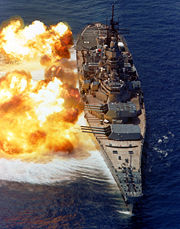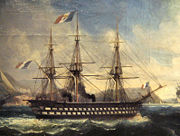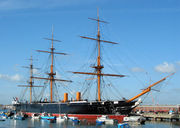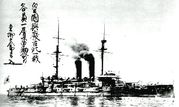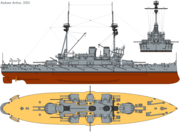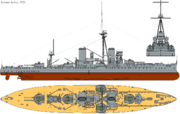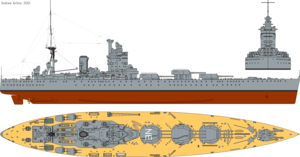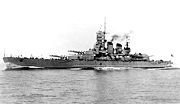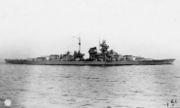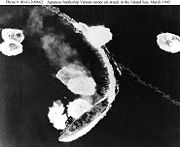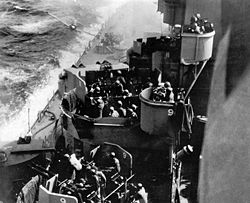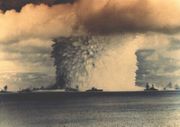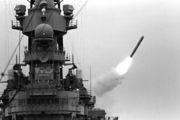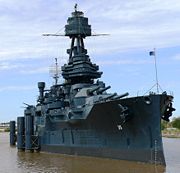Battleship
2008/9 Schools Wikipedia Selection. Related subjects: World War II
A battleship is a large, heavily armored warship with a main battery consisting of the largest calibre of guns. Battleships are larger, better armed, and better armored than cruisers and destroyers.
Battleship design continually evolved to incorporate and adapt technological advances to maintain an edge. The word battleship was coined around 1794 and is a shortened form of line-of-battle ship, the dominant warship in the Age of Sail. The term came into formal use in the late 1880s to describe a type of ironclad warship, whose design culminated in the Battle of Tsushima on 27 May 1905. This generation of warships were now referred to as pre-dreadnought battleships. In October 1905, nearly five months after Tsushima, the keel of HMS Dreadnought (launched in 1906) was laid down, heralding a revolution in battleship design, battleships constructed from 1906 onward were often referred to as dreadnoughts.
Battleships were a potent symbol of naval dominance and national might, and for decades the battleship was a major factor in both diplomacy and military strategy. The global arms race in battleship construction in the early 20th century was one of the causes of World War I, which saw a clash of huge battle fleets at the Battle of Jutland. The Naval Treaties of the 1920s and 1930s limited the number of battleships but did not end the evolution of design. Both the Allies and the Axis Powers deployed battleships of old construction and new during World War II.
Nevertheless, some historians and naval theorists question the value of the dreadnought. Apart from Jutland, there were few great dreadnought clashes. Despite their great firepower and protection, dreadnoughts remained vulnerable to much smaller, cheaper ordnance and craft: initially the torpedo and the naval mine, and later aircraft and the guided missile. The growing range of engagement led to the battleship's replacement as the leading type of warship by the aircraft carrier during World War II; battleships were retained by the United States Navy into the Cold War only for fire support purposes. These last battleships were removed from the U.S. Naval Vessel Register in March 2006.
The ship of the line
A ship of the line was a large, unarmoured wooden sailing ship on which was mounted a battery of up to 120 smoothbore guns and carronades. The ship of the line was a gradual evolution of a basic design that dates back to the 1400s, and, apart from growing in size, it changed little between the adoption of line of battle tactics in the early 17th century and the end of the sailing battleship's heyday in the 1830s. From 1794, the alternative term 'line of battle ship' was contracted (informally at first) to 'battle ship' or 'battleship'.
The sheer number of guns fired broadside meant that a sailing battleship could wreck any wooden vessel, smashing its hull and masts and killing its crew. However, the effective range of the guns was as little as a few hundred yards, and the battle tactics of sailing ships depended entirely on the wind.
The first major change to the ship of the line concept was the introduction of steam power as an auxiliary propulsion system. Steam power was gradually introduced to the navy in the first half of the 19th century, initially for small craft and later for frigates. The French Navy introduced steam to the line of battle with the 90-gun Le Napoléon in 1850 — the first true steam battleship. Napoleon was armed as a conventional ship-of-the-line, but her steam engines could give her a speed of 12 knots (22 km/h), regardless of the wind conditions: a potentially decisive advantage in a naval engagement. The introduction of steam accelerated the growth in size of battleships. France and the United Kingdom were the only two countries to develop fleets of wooden steam screw battleships, although several other navies made some use of a mixture of screw battleships and paddle-steamer frigates. These included Russia, Turkey, Sweden, Naples, Prussia, Denmark and Austria.
Ironclads
The adoption of steam power was only one of a number of technological advances which revolutionized warship design in the 19th century. The ship of the line was overtaken by the ironclad: powered by steam, protected by metal armor, and armed with guns firing high-explosive shells.
Explosive shells
Wooden-hulled ships stood up comparatively well to solid shot, as shown in the 1866 battle of Lissa, where the old Austrian steam battleship Kaiser ranged across a confused battlefield, rammed an Italian ironclad and took a pounding of several 300 pound shots at point blank range. Despite losing her bowsprit and her foremast, and being set on fire, she was ready for action again the very next day. By contrast, guns which fired explosive or incendiary shells were a major threat to wooden ships, and these weapons became widespread in the 1840s. In the Crimean War, the Russian Black Sea Fleet destroyed a flotilla of wooden Turkish ships with explosive shells at the Battle of Sinop in 1853. Later in the war, French ironclad floating batteries used similar weapons against the defenses at the Battle of Kinburn.
Iron armor and construction
The development of high-explosive shells made the use of iron armor plate on warships necessary. In 1859 France launched La Gloire, the first ocean-going ironclad warship. She had the profile of a ship of the line, cut to one deck due to weight considerations. Although made of wood and reliant on sail for most of her journeys, La Gloire was fitted with a propeller, and her wooden hull was protected by a layer of thick iron armor. Gloire prompted further innovation from the Royal Navy, anxious to prevent France from gaining a technological lead.
The superior armored frigate Warrior followed La Gloire by only fourteen months, and both nations embarked on a program of building new ironclads and converting existing screw ships of the line to armored frigates. Within two years, Italy, Austria, Spain and Russia had all ordered ironclad warships, and by the time of the famous clash of the USS Monitor and the CSS Virginia at the Battle of Hampton Roads at least eight navies possessed ironclad ships.
Navies experimented with the positioning of guns, in turrets (like the USS Monitor), central-batteries or barbettes, or with the ram as the principal weapon. As steam technology developed, masts were gradually removed from battleship designs. By the mid-1870s steel was used as a construction material alongside iron and wood. The French Navy's Redoutable, laid down in 1873 and launched in 1876, was a central battery and barbette warship which became the first battleship in the world to use steel as the principal building material.
The pre-dreadnought battleship
By the 1890s, there was an increasing similarity between battleship designs, and the type now known as the 'pre-dreadnought battleship' emerged. These were heavily armored ships, mounting a mixed battery of guns in turrets, and without sails. The typical first-class battleship of the pre-dreadnought era displaced 15,000 to 17,000 tons, had a speed of 16 knots (30 km/h), and an armament of four 12-inch (305 mm) guns in two turrets fore and aft with a mixed-caliber secondary battery amidships around the superstructure. An early design with superficial similarity to the pre-dreadnought is the British Devastation-class of 1871. However, it was not until the 1890s that the widespread adoption of steel construction and hardened steel armor meant that a turret-ship could combine heavy armament and protection with high speed and good seakeeping.
The slow-firing 12-inch (305 mm) main guns were the principal weapons for battleship-to-battleship combat. The intermediate and secondary batteries had two roles. Against major ships, it was thought a 'hail of fire' from quick-firing secondary weapons could distract enemy gun crews by inflicting damage to the superstructure, and they would be more effective against smaller ships such as cruisers. Smaller guns (12-pounders and smaller) were reserved for protecting the battleship against the threat of torpedo attack from destroyers and torpedo boats.
The beginning of the pre-dreadnought era coincided with an attempt by Britain to re-assert her naval dominance. For many years previously, Britain had taken naval supremacy for granted. Expensive naval projects were criticised by political leaders of all inclinations. However, in 1888 a war scare with France and the build-up of the Russian navy gave added impetus to naval construction, and the British Naval Defence Act of 1889 laid down a new fleet including eight new battleships. The principle that Britain's navy should be more powerful than the two next most powerful fleets combined was also enshrined. This policy was designed to deter France and Russia from building more battleships, but both nations nevertheless expanded their fleets with more and better pre-dreadnoughts in the 1890s.
In the last years of the 19th century and the first years of the 20th, the escalation in the building of battleships became defined by conflict between Britain and Germany. The German naval laws of 1890 and 1898 authorised a fleet of 38 battleships, a vital threat to the balance of naval power. Britain answered with further shipbuilding, but by the end of the pre-dreadnought era, British supremacy at sea had markedly weakened. In 1883, the United Kingdom had 38 battleships, twice as many as France and almost as many as the rest of the world put together. By 1897, Britain's lead was far smaller due to competition from France, Germany, and Russia, as well as the development of pre-dreadnought fleets in Italy, the United States and Japan. Turkey, Spain, Sweden, Denmark, Norway, the Netherlands, Chile and Brazil all had second-rate fleets led by armored cruisers, coastal defence ships or monitors.
Pre-dreadnoughts continued the technical innovations of the ironclad. Turrets, armor plate, and steam engines were all improved over the years, and torpedo tubes were introduced. A small number of designs, including the American Kearsarge and Virginia classes, experimented with all or part of the 8-inch intermediate battery superimposed over the 12-inch primary. Results were poor: recoil factors and blast effects resulted in the 8-inch battery being completely unusable, and the inability to train the primary and intermediate armaments on different targets led to significant tactical limitations. Even though such innovative designs saved weight (a key reason for their inception), they proved too cumbersome in practice.
The Dreadnought era
In 1906, the revolutionary HMS Dreadnought, created as a result of pressure from Admiral John A. Fisher, made existing battleships obsolete. Combining an 'all-big-gun' armament of ten 12-inch (305 mm) rifles with unprecedented speed and protection, she prompted navies worldwide to re-evaluate their battleship building programmes. While the Japanese had laid down an all-big-gun battleship (Satsuma) in 1904, and the concept of an all-big-gun ship had been in circulation for several years, it had yet to be validated in combat. Dreadnought sparked a new arms race, principally between Britain and Germany but reflected worldwide, as the new class of warships became a crucial element of national power.
Technical development continued rapidly through the dreadnought era, with step changes in armament, armor and propulsion. Ten years after Dreadnought's commissioning, much more powerful ships, the super-dreadnoughts, were being built.
The origin of Dreadnought
In the first years of the 20th century, several navies worldwide experimented with the idea of a new type of battleship with a uniform armament of very heavy guns.
General Vittorio Cuniberti, the Italian Navy's chief naval architect, articulated the concept of an all-big-gun battleship in 1903. When the Regia Marina did not pursue his ideas, Cuniberti wrote an article in Jane's proposing an "ideal" future British battleship, a large armored warship of 17,000 tons, armed solely with a single caliber main battery (twelve 12-inch {305 mm} guns), carrying 300-millimetre (12 in) belt armor, and capable of 24 knots (44 km/h).
The Russo-Japanese War provided operational experience to validate the 'all-big-gun' concept. At the Yellow Sea and Tsushima, pre-dreadnoughts exchanged volleys at ranges of 7,600–12,000 yd (7 to 11 km), beyond the range of the secondary batteries. It is often held that these engagements demonstrated the importance of the 12-inch (305 mm) gun over its smaller counterparts, though some historians take the view secondary batteries were just as important as the larger weapons.
![The Imperial Japanese Navy's Satsuma (1906); an early design for this ship specified "all-big-gun" armament, but financial pressures precluded that.[citation needed]](../../images/260/26061.jpg)
The Imperial Japanese Navy's battleship Satsuma became the first ship in the world designed (1904) as an all-big-gun battleship. However, she was never armed to specification, due to the financial pressures of the Russo-Japanese War, and was completed with a mixed armament. For this reason, the new all-big-gun battleships would not be called Satsumas but Dreadnoughts, after the first such ship actually completed, in 1906. Satsuma also retained triple-expansion engines, though her sister ship Aki, completed in 1911, used turbines.
As early as 1904, First Sea Lord Sir John A. "Jackie" Fisher had been convinced of the need for fast, powerful ships with an all-big-gun armament. If Tsushima influenced his thinking, it was to persuade him of the need to standardise on 12 inch guns. Fisher's concern was submarines and destroyers equipped with torpedoes that outranged battleship guns, making speed imperative for capital ships. Fisher's preferred option was his brainchild, the battlecruiser: lightly armored but heavily armed with eight 12 inch guns and propelled to a remarkable 25 knots (46 km/h) by steam turbines.
It was to prove this revolutionary technology that Dreadnought was designed in January 1905, laid down in October 1905 and sped to completion by 1906. She carried ten 12 inch guns, had an 11-inch armour belt, and was the first large ship powered by turbines. She mounted her guns in five turrets; three on the centerline (one forward, two aft) and two on the wings, giving her at her launch twice the broadside of anything else afloat. She retained a number of 12-pound (3-inch, 76 mm) quick-firing guns for use against destroyers and torpedo-boats. Her armor was heavy enough for her to go head-to-head with any other ship afloat in a gun battle, and conceivably win.
Dreadnought was to have been followed by three Invincible-class battlecruisers, their construction delayed to allow lessons from Dreadnought to be used in their design. While Fisher may have intended Dreadnought to be the last Royal Navy battleship, the design was so successful he found little support for his plan to switch to a battlecruiser navy. Although there were some problems with the ship (the wing turrets had limited arcs of fire and strained the hull when firing a full broadside, and the top of the thickest armor belt lay below the waterline at full load), the Royal Navy promptly commissioned another six ships to a similar design in the Bellerophon and St Vincent classes.
An American design, South Carolina, authorized in 1905 and laid down in December 1906, was also one of the first dreadnoughts, but she and her sister, Michigan, were not launched until 1908. Both used triple-expansion engines, but had superior layout of their main battery, dispensing with Dreadnought's wing turrets. They thus retained the same broadside, despite having two fewer guns.
The dreadnought arms race
In 1897, before the revolution in design brought about by Dreadnought, the Royal Navy had 62 battleships in commission or building, a lead of 26 over France and 50 over Germany. In 1906, the Royal Navy owned the field with Dreadnought. The new class of ship prompted an arms race with major strategic consequences. Major naval powers raced to build their own dreadnoughts to catch up with the United Kingdom. Possession of modern battleships was not only vital to naval power, but also, as with nuclear weapons today, represented a nation's standing in the world. Germany, France, Russia, Italy, Austria, and the United States all began dreadnought programmes; and second-rank powers including Turkey, Argentina, Brazil, and Chile commissioned dreadnoughts to be built in British and American yards.
World War I
The First World War was an anticlimax for the great dreadnought fleets. There was no decisive clash of modern battlefleets to compare with the Battle of Tsushima. The role of battleships was marginal to the great land struggle in France and Russia; and it was equally marginal to the First Battle of the Atlantic, the battle between German submarines and British merchant shipping.
By virtue of geography, the Royal Navy could keep the German High Seas Fleet bottled up in the North Sea with relative ease. Both sides were aware that, because of the greater number of British dreadnoughts, a full fleet engagement would likely result in a British victory. The German strategy was therefore to try to provoke an engagement on their terms: either to induce a part of the Grand Fleet to enter battle alone, or to fight a pitched battle near the German coastline, where friendly minefields, torpedo-boats and submarines could be used to even the odds.
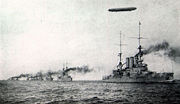
The first two years of war saw conflict in the North Sea limited to skirmishes by battlecruisers at the Battle of Heligoland Bight and Battle of Dogger Bank and raids on the English coast. In the summer of 1916, a further attempt to draw British ships into battle on German terms resulted in a clash of the battlefleets in the Battle of Jutland: an indecisive engagement.
In the other naval theatres there were no decisive pitched battles. In the Black Sea, engagement between Russian and Turkish battleships was restricted to skirmishes. In the Baltic, action was largely limited to the raiding of convoys, and the laying of defensive minefields; the only significant clash of battleship squadrons there was the Battle of Moon Sound at which one Russian pre-dreadnought was lost. The Adriatic was in a sense the mirror of the North Sea: the Austro-Hungarian dreadnought fleet remained bottled up by the British and French blockade. And in the Mediterranean, the most important use of battleships was in support of the amphibious assault on Gallipoli.{{Fact}
The course of the war also illustrated the vulnerability of battleships to cheaper weapons. In September 1914, the potential threat posed to capital ships by German U-boats was confirmed by successful attacks on British cruisers, including the sinking of three British armored cruisers by the German submarine U-9 in less than an hour. Sea mines proved a threat the next month, when the recently commissioned British super-dreadnought Audacious struck a mine. By the end of October, the British had changed their strategy and tactics in the North Sea to reduce the risk of U-boat attack. While Jutland was the only major clash of battleship fleets in history, the German plan for the battle relied on U-boat attacks on the British fleet; and the escape of the German fleet from the superior British firepower was effected by the German cruisers and destroyers closing on British battleships, causing them to turn away to avoid the threat of torpedo attack. Further near-misses from submarine attacks on battleships and casualties amongst cruisers led to growing paranoia in the Royal Navy about the vulnerability of battleships. By October 1916, the Royal Navy had essentially abandoned the North Sea, instructing the Grand Fleet not to go south of the Farne Islands unless adequately protected by destroyers.
The German High Seas Fleet, for their part, were determined not to engage the British without the assistance of submarines; and since the submarines were needed more for raiding commercial traffic, the fleet stayed in port for the remainder of the war. Other theatres equally showed the role of small craft in damaging or destroying dreadnoughts. The two Austrian dreadnoughts lost in 1918 were the casualties of torpedo boats and of frogmen. The Allied capital ships lost in Gallipoli were sunk by mines and torpedo, while a Turkish pre-dreadnought was caught in the Dardanelles by a British submarine.
The inter-war period
The inter-war period saw the battleship subjected to strict international limitations to prevent a costly arms race breaking out.
For many years, Germany simply had no battleships. The Armistice with Germany required that most of the High Seas Fleet be disarmed and interned in a neutral port; largely because no neutral port could be found, the ships remained in British custody in Scapa Flow, Scotland. The Treaty of Versailles specified that the ships should be handed over to the British. Instead, most of them were scuttled by their German crews on 21 June 1919 just before the signature of the peace treaty. The treaty also limited the German Navy, and prevented Germany from building or possessing any capital ships.
While the victors were not limited by the Treaty of Versailles, many of the major naval powers were crippled after the war. Faced with the prospect of a naval arms race against Great Britain and Japan, which would in turn have led to a possible Pacific war, the United States was keen to conclude the Washington Naval Treaty of 1922. This treaty limited the number and size of battleships that each major nation could possess, and required Britain to accept parity with the U.S. and to abandon the British alliance with Japan. The Washington treaty was followed by a series of other naval treaties, including the First Geneva Naval Conference (1927), the First London Naval Treaty (1930), the Second Geneva Naval Conference (1932), and finally the Second London Naval Treaty (1936), which all set limits on major warships. These treaties became effectively obsolete on 1 September 1939 at the beginning of World War II, but the ship classifications that had been agreed upon still apply. The treaty limitations meant that fewer new battleships were launched from 1919–1939 than from 1905–1914. The treaties also inhibited development by putting maximum limits on the weights of ships. Designs like the projected British N3 battleship, the first American South Dakota-class, and the Japanese Kii-class—all of which continued the trend to larger ships with bigger guns and thicker armor—never got off the drawing board. Those designs which were commissioned during this period were referred to as treaty battleships.
Rise of the aircraft carrier
As early as 1914, the British Admiral Percy Scott predicted that battleships would soon be made irrelevant by aeroplanes. By the end of World War I, aeroplanes had successfully adopted the torpedo as a weapon. A proposed attack on the German fleet at anchor in 1918 using the Sopwith Cuckoo carrier-borne torpedo-bomber was considered and rejected—but it was not long before such a technique was adopted.
In the 1920s, General Billy Mitchell of the United States Army Air Corps, believing that air forces had rendered navies around the world obsolete, testified in front of Congress that "1,000 bombardment airplanes can be built and operated for about the price of one battleship" and that a squadron of these bombers could sink a battleship, making for more efficient use of government funds. This infuriated the U.S. Navy, but Mitchell was nevertheless allowed to conduct a careful series of bombing tests alongside Navy and Marine bombers. In 1921, he bombed and sank numerous ships, including the "unsinkable" German World War I battleship Ostfriesland and the American pre-dreadnought Alabama.
Although Mitchell had required "war-time conditions", the ships sunk were obsolete, stationary, defenseless and had no damage control. The sinking of Ostfriesland was accomplished by violating an agreement that would have allowed Navy engineers to examine the effects of various munitions: Mitchell's airmen disregarded the rules, and sank the ship within minutes in a coordinated attack. The stunt made headlines, and Mitchell declared, "No surface vessels can exist wherever air forces acting from land bases are able to attack them." While far from conclusive, Mitchell's test was significant because it put proponents of the battleship against naval aviation on the back foot. Rear Admiral William A. Moffett used public relations against Mitchell to make headway toward expansion of the U.S. Navy's nascent aircraft carrier program.
Rearmament
The Royal Navy, United States Navy, and Imperial Japanese Navy extensively upgraded and modernized their WWI-era battleships during the 1930s. Among new features were tower height and stability such that optical rangefinder equipment for gunnery control could be used, deck plating was increased especially around turrets against plunging fire and aerial bombing, anti-aircraft weapons added. Some British ships received a large block superstructure nicknamed the "Queen Anne's castle", such as in the Queen Elizabeth and Warspite, which would be used in the new conning towers of the King George V fast battleships. External bulges were added to improve both buoyancy to counteract weight increase and provide underwater protection against mines and torpedoes. The Japanese rebuilt all of their battleships, plus their battlecruisers, with distinctive " pagoda" structures, though the Hiei received a more modern bridge tower that would influence the new Yamato battleships. Bulges were fitted, including steel tube array to improve both underwater and vertical protecion along waterline. The U.S. experimented with tripod and later caged masts, though after Pearl Harbour some of the most severely damaged ships such as West Virginia and California were rebuilt to a similar appearance to their fast battleship contemporaries. Radar, which was effective beyond visual contact and was effective in complete darkness or adverse weather conditions, was introduced to supplement optical fire control.
Even when war threatened again in the late 1930s, battleship construction did not regain the level of importance which it had held in the years before World War I. The "building holiday" imposed by the naval treaties meant that the building capacity of dockyards worldwide was relatively reduced, and the strategic position had changed. The development of the strategic bomber meant that the navy was no longer the only method of projecting power overseas, and the development of the aircraft carrier meant that battleships had a rival for the resources available for capital ship construction.
In Germany, the ambitious Plan Z for naval rearmament was abandoned in favour of a strategy of submarine warfare supplemented by the use of battlecruisers and Bismarck-class battleships as commerce raiders. In Britain, the most pressing need was for air defenses and convoy escorts to safeguard the civilian population from bombing or starvation, and re-armament construction plans consisted of five ships of the King George V class. It was in the Mediterranean that navies remained most committed to battleship warfare. France intended to build six battleships of the Dunkerque and Richelieu classes, and the Italians two powerful Littorio-class ships. Neither navy built significant aircraft carriers. The U.S. preferred to spend limited funds on aircraft carriers until the South Dakota class. Japan, also prioritising aircraft carriers, nevertheless began work on three mammoth Yamato class ships (although one of these was later completed as a carrier).
At the outbreak of the Spanish Civil War, the Spanish navy consisted of only two small dreadnought battleships, España and Jaime I. España (originally named Alfonso XIII), by then in reserve at the northwestern naval base of El Ferrol, fell into Nationalist hands in July 1936. The crew aboard Jaime I murdered their officers, mutinied, and joined the Republican Navy. Thus each side had one battleship; however, the Republican Navy generally lacked experienced officers. The Spanish battleships mainly restricted themselves to mutual blockades, convoy escort duties, and shore bombardment, rarely in direct fighting against other surface units. In April 1937, España ran onto a mine laid by friendly forces, and sank with little loss of life. In May 1937, Jaime I was damaged by Nationalist air attacks and a grounding incident. The ship was forced to go back to port to be repaired. There she was again hit by several aerial bombs. It was then decided to tow the battleship to a more secure port, but during the transport she suffered an internal explosion that caused 300 deaths and her total loss. Several Italian and German capital ships participated in the non-intervention blockade. On May 29, 1937, two Republican aircraft managed to bomb the German pocket battleship Deutschland outside Ibiza, causing severe damage and loss of life. Admiral Scheer retaliated two days later by bombarding Almería, causing much destruction, and the resulting Deutschland incident meant the end of German and Italian support for non-intervention.
World War II
German battleships—obsolete pre-dreadnoughts—fired the first shots of World War II with the bombardment of the Polish garrison at Westerplatte; and the final surrender of the Japanese Empire took place aboard a United States Navy battleship, the USS Missouri. Between the two events, it became clear that battleships were now essentially auxiliary craft, and aircraft carriers were the new principal ships of the fleet.
Still, battleships played a part in major engagements in Atlantic, Pacific and Mediterranean theatres. In the Atlantic, the Germans experimented with taking the battleship beyond conventional fleet action, using their pocket battleships as independent commerce raiders. Although there were a few battleship-on-battleship engagements, battleships had little impact on the destroyer and submarine Battle of the Atlantic, and aircraft carriers determined the outcome of most of the decisive fleet clashes of the Pacific War.
In the first year of the war, battleships and battlecruisers defied predictions that aircraft would dominate naval warfare. Scharnhorst and Gneisenau surprised and sank the aircraft carrier Glorious off western Norway in June 1940. The vulnerability of unescorted carriers to attack by other ships meant that carriers almost always had escorts, so this engagement marked the last time surface gunnery sank a fleet carrier. In the Attack on Mers-el-Kébir, British capital ships opened fire on the French battleships harboured in Algeria with their own heavy guns, and later pursued fleeing French ships with planes from aircraft carriers.
Taranto and Matapan
In late 1940 and 1941, a range of engagements saw battleships harassed by carrier aircraft.
The first example of the power of naval aviation was the British air attack on the Italian naval base at Taranto that took place on the night of 11–12 November 1940. A small number of Royal Navy aircraft attacked the Italian fleet at harbour, succeeding in sinking one Italian battleship and damaging two others. Importantly, the attack forced the Italian navy to change tactics and seek battle against the superior British navy, which resulted in their defeat at the Battle of Cape Matapan.
Bismarck
The battleship war in the Atlantic was driven by the attempts of German capital ship commerce raiders—two battleships, the Bismarck and the Tirpitz, and two battlecruisers—to influence the Battle of the Atlantic by destroying Atlantic convoys supplying the United Kingdom. The superior numbers of British surface units devoted themselves to protecting the convoys, and to seek-and-destroy missions against the German ships, assisted by both naval and land-based aircraft and by sabotage attacks. On 24 May 1941, during its attempt to break out into the North Atlantic, the commerce raider Bismarck engaged the British battleship HMS Prince of Wales and the battlecruiser Hood. Due primarily to the Bismarck's superior range-finding and accuracy, it soon sank Hood with a hit to her magazines. Bismarck and Prince of Wales hit each other three times, the damage compelling the Prince of Wales to withdraw. While the Bismarck was heading for St. Nazaire, the Royal Navy continued to hunt it, and eventually an attack by Swordfish biplane torpedo-bombers from the aircraft carrier Ark Royal disabled Bismarck's rudder. This enabled Royal Navy battleships, cruisers and destroyers to close in for the kill.
The Pacific battles
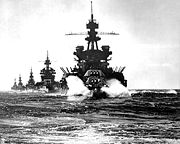
In many of the crucial battles of the Pacific, for instance Coral Sea and Midway, battleships were either absent or overshadowed as carriers launched wave after wave of planes into the attack at a range of hundreds of miles. The primary tasks for battleships in the Pacific became shore bombardment and anti-aircraft defense for the carriers. Even the largest battleships ever constructed, Japan's Yamato class, which carried a main battery of nine 18.1- inch (460 millimetre) guns and were designed to be a principal strategic weapon, were seldom given a chance to fulfill their potential. They were hampered by technical deficiencies (slow battleships were incapable of operating with fast carriers), faulty military doctrine (the Japanese waited for a "decisive battle", which never came), and defective dispositions (as at Midway).
Pearl Harbour
Before hostilities broke out in the Pacific Theatre, extensive pre-war planning centered around dreadnoughts. The Royal Navy could not achieve parity with the estimated nine Japanese capital ships in Southeast Asia, since doing so would leave only a handful of ships to use against Nazi Germany. However, Prime Minister Winston Churchill was optimistic about the improving situation in the North Atlantic and Mediterranean and allocating two ships to the defense of Singapore was seen as a compromise. Furthermore, the U.S. Navy later agreed to send its Pacific Fleet with its eight battleships to Singapore in the event of hostilities with Japan.
On 7 December 1941 the Japanese launched a surprise attack on Pearl Harbour. Five out of eight U.S. battleships were quickly either sunk or sinking, with the rest damaged. The Japanese thus neutralized the U.S. battleship force in the Pacific by an air attack, and thereby proved Mitchell's theory, and showed the vulnerability of warships lying at anchor, as at Taranto. The American aircraft carriers were however at sea and evaded detection. They in turn took up the fight, eventually turning the tide of the war in the Pacific.
The sinking of the British battleship Prince of Wales and her escort, the battlecruiser HMS Repulse, further demonstrated the vulnerability of a battleship to air attack, in this case while at sea without air cover. Both ships were on their way to assist in the defense of Singapore when Japanese land-based bombers and fighters found and sank them on 10 December 1941. Prince of Wales has the distinction of being the first modern battleship sunk by aircraft while underway and able to defend herself.
Midway
Commonly understood as a victory of carriers, Midway showed up deficiencies in Japanese operational planning. Yamamoto, considering them his most valuable units, kept his battleships far to the rear, in line with traditional practice. This placed them too far away to assist Nagumo (and they would have been too slow to keep up with him in any case). Yet, when Nagumo's carriers were sunk, Yamamoto lost an opportunity to salvage something. Carriers, for all their evident potency, were virtually defenseless at night, and Fletcher might have been dealt a crushing blow by Yamato the night of 6– 7 June, had Yamamoto stayed closer.
Guadalcanal
Initially, when the U.S. entered the war in December 1941, it had no battleships available in the Pacific Theatre. Eight of them were sunk or crippled at Pearl Harbour and were sent home for repairs and reconstruction; they would not have been able to keep up with the carriers in any case. The new fast battleships of North Carolina and South Dakota classes were still undergoing trials. North Carolina and South Dakota were ready by summer of 1942 and provided crucial anti-aircraft defense during the Eastern Solomons and Santa Cruz Islands carrier battles.
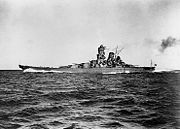
By contrast, the Imperial Japanese Navy had the advantage of a dozen operational battleships early in the war, but chose not to deploy them in any significant engagements. The Fusōs and Ises, despite their extensive modernization and respectable speeds, were relegated to training and home defense, while the Nagatos and Yamatos were being saved for Isoroku Yamamoto's "Decisive Battle" which never came to fruition on Japanese terms. In fact, the only Japanese battleships to see much action in the early stages were Kongōs, which served mostly as carrier escorts due to their high speed.
During the later part of the Guadalcanal campaign in fall 1942, Japan and the U.S. were both forced to commit their battleships to surface combat, due to the need to carry out night operations, and because of the exhaustion of their carrier forces. During the First Naval Battle of Guadalcanal, battleships Hiei and Kirishima were driven off by a force of U.S. cruisers and destroyers. Several USN ships were lost and others were crippled, but they inflicted critical damage on Hiei, which was abandoned after being subject to repeated air attacks that made salvage impossible. The following evening, at the Second Naval Battle of Guadalcanal on 15 November 1942, the United States battleships South Dakota and Washington fought and destroyed the surviving Kirishima.
It was also at Guadalcanal that battleships demonstrated the other primary use to which they would be put, delivering devastating fire against Henderson Field.
Leyte Gulf
At the Battle of the Philippine Sea, heavy aircraft losses made the carriers ineffectual and forced the Japanese to finally commit their dreadnoughts, both old and new, to the upcoming Leyte Campaign. The objective in this "decisive battle" was to stop the Allies from capturing the Philippines, which would cut off the Japanese oil supply and render their navy useless. The Battle off Samar, on 25 October 1944, proved battleships were still lethal. The American escort carriers of "Taffy 3" had a narrow escape from under the guns of Japanese battleships Yamato, Kongō, Haruna and Nagato and their cruiser escort. American destroyers and aircraft attacked the battleships, enabling the American task force to disengage. Inexplicably, the Japanese disengaged as well, despite being near their intended target - the American amphibious landing forces at Leyte.
At Leyte Gulf, on 25 October 1944, six old battleships (many of them raised and repaired from Pearl Harbour), led by Admiral Jesse Oldendorf of the U.S. Seventh Fleet sank Admiral Shoji Nishimura's flagship Yamashiro and would have sunk Fusō if it had not already been broken in two by destroyer torpedoes moments earlier during the Battle of Surigao Strait. This engagement marked the last time in history when battleship faced battleship. It was also the day after an engagement further north (the Battle of the Sibuyan Sea) in which Musashi, sister ship to Yamato, was sunk by aircraft long before she could come within striking range of the American force.
Soviet and Finnish battles
During the Soviet-Finnish Winter War, the Soviet battleships Marat and Oktyabrskaya Revolutsiya made several attempts to neutralize the Finnish coastal batteries in order to implement a full naval blockade. The Soviets inflicted little damage on the Finnish positions, and the defenders hit back, claiming at least one hit on Marat. During the German assault on the Soviet Union, the Soviet battleships served as convoy escorts during the evacuation of Tallinn, and as floating batteries during the siege of Leningrad. The dense German and Finnish minefields and the submarine nets effectively restricted Soviet traffic in the Gulf of Finland, forcing the larger vessels to remain at port. The German Stuka pilot Hans-Ulrich Rudel eventually sank Marat at her moorings on 23 September 1941. Still, the vessel was able to serve as a battery for the remainder of the siege. The Soviets later refloated Marat and both it and Oktyabrskaya Revolutsiya served until the 1950s.
Fire support
With the German capital-ship raiders sunk or forced to remain in port, shore bombardment became the focus of Allied battleships in the Atlantic. It was while covering the Allied invasion of Morocco that the Massachusetts fought and disabled Vichy French battleship Jean Bart on 27 October 1942. Six battleships came together as part of Operation Neptune, in support of the D-Day landings in June 1944. D-Day also saw the humble sacrifice of two obsolete dreadnoughts, which were sunk as part of the breakwater around the Allied Mulberry harbours.
Aerial defense
The sinking of Prince of Wales and Repulse off the coast of Malaya in 1941 demonstrated that even the most modern battleships could not hold off aerial attacks without decent aerial defenses. The British HACS fire control system had proven useless against the Japanese attackers, and the anti-aircraft artillery had managed to shoot down only a handful of attackers. Afterwards, an aircraft carrier's combat air patrol proved to be the most effective form of defense against enemy bombers; nonetheless a modern fast battleship could provide a vital point defense against attackers that broke through the fighter screen. The North Carolina and South Dakota demonstrated just that in the battles of the Eastern Solomons and Santa Cruz Islands, respectively, with North Carolina downing between 7 and 14 planes, while South Dakota shot down between 26 and 32. The battleships' presence was crucial during these 1942 battles, as the U.S. were still months from being able to realize their material advantage, with too few planes and ships to interdict enough of the skilled Japanese pilots. No American battleships were lost or seriously damaged by aerial attacks in open seas in World War II.
By 1944, Admiral Raymond A. Spruance had arrayed his forces in a complex defense formation. The first line of protection was a radar-vectored combat air patrol, and any attackers who managed to get through would face anti-aircraft fire from a line of screening battleships and cruisers. This exacted such a heavy toll on the Japanese during the Battle of the Philippine Sea that they failed to cause any significant damage to their main targets, the aircraft carriers. The most damage that the Japanese caused was a bomb hit on South Dakota which caused many casualties but did little damage to the battleship. Circumstances were vastly different from 1942 as the Japanese aircrews were inexperienced, and they were up against veteran U.S. pilots as well as many new carriers and battleships.
AA guns
At the outbreak of World War II, most battleships had large anti-aircraft batteries. The battleships used the same light AA guns (the Allies used autocannons such as the Bofors 40 mm gun and Oerlikon 20 mm cannon) as those on smaller ships, but in greater number. The later development of proximity fuses and radar vastly increased the effectiveness of these batteries.
Post-WWI battleships, particularly British and American, had discarded the casemates in favour of turret-mounted dual purpose secondary batteries ( 5-inch or 6-inch caliber). Secondaries were initially designed to deal with rushing destroyers and torpedo boats, but there arose a need for heavy anti-aircraft armament as the potency of aircraft grew, particularly torpedo planes. The rationale was that it is unlikely that a battleship would be simultaneously facing both destroyers and aircraft, but it would take up too much space to have separate types of guns to deal with both threats. Both weapons had similar calibers and so they could be merged into a single battery type, and the turret mountings were less susceptible to flooding and had a better firing arc than casemates. The space saved from combining the two types of guns added to simplification of supply, increased deck armour coverage, stowage of other equipment, more light anti-aircraft batteries, and other needs.
The Nelson class battleship, incorporating many concepts from the G3 battlecruiser, was the first design to include a dual-purpose secondary battery, useful against both surface and airborne attacks. Compared to light AA they had a slower rate of fire, but they had a greater range and sufficient punch to knock enemy planes out of the sky. This proved a crucial defense against Japanese kamikazes in the latter years of WWII. They could also fire into the sea to create waterspouts that slapped low-flying torpedo planes with tonnes of water. Battleships could mount many more of these DP batteries than cruisers or carriers.
German vessels such as the Bismarck class possessed dedicated secondary anti-ship batteries as well as dedicated heavy anti-aircraft batteries, rather than adopting the dual-purpose secondaries like the British or Americans. Bismarck for instance had a battery of twelve 5.9 inch (150 mm) cannon and another sixteen 4.1 inch (105 mm) battery was mounted to deal with air threats. The cannon could be used against ships only, as they could not be elevated to fire on high-level targets. This tended to complicate ammunition supplies, take up more space, and reduce the numbers of both guns (reducing the anti-ship or anti-aircraft broadside). The Imperial Japanese Navy suffered similar problems to the Germans', as their secondaries were too slow to track aircraft.
The Japanese even used the "San Shiki" (the Beehive) Model 13 anti-aircraft shell for the main gun armament of the Yamato class battleships, which would have in theory functioned as a super-sized "shotgun", though this was not considered a success.
Armour
In the aftermath of the Battle of Jutland and post-WWI era, designers began drawing up armour schemes that protected against ordnance dropped by aircraft or submarines. The five ships of the American Tennessee and Colorado classes had considerably improved underwater hull protection over previous battleships, as the result of extensive experimentation and testing. The new class of Battleship was to include 40" of armored plating. The proposed G3 battlecruiser was planned to incorporate a thoroughly tested torpedo defense scheme, which was later used in the Nelson-class. Not surprisingly, as many WWI battleships lacked such a protection system, they fared poorly against torpedoes, which in WWII were increasingly being delivered by submarines and aircraft.
Battleships had an armoured belt along the waterline. It was intended to stop shells that hit their sides and to prevent flooding by underwater explosions due to near misses. WWI battleship, German and Italian WWII battleships had lighter upper armoured belts to protect sides up to the main or weather deck. Main belt thickness along the waterline ranged from 10" to 15", upper belt thickness ranged from 4" to 10". Most ships of the WWII period had a sloped main belt (internal in some classes), to increase resistance to incoming shells; and no upper belt, to save weight. Thicknesses of belt armour ranged from 10" for Strasbourg class - large battlecruisers rather than pure battleships - or from 12" South Dakota and Iowa classes) to 16" ( Yamato class).
WWI ships had a light upper armoured deck to protect the secondary guns and a main armoured deck whose sides sloped down to meet the lower edge of the belt, but their thickness was usually no more than 1.5", or 2" for the slopes. As soon as long-range engagements became common and aerial threats increased, crash programs to improve deck and turret roof protection started. US Navy "all-or-nothing" armour layout introduced a flat heavy armour deck, which abutted the upper edges of the armoured belt, and light armoured weather and lower decks: this design was used by all WWII ships except Reichsmarine units, that kept an heavier lower deck and a lighter upper deck. Main deck armour thickness ranged from 4" to 6" or even 8" for Yamato class, usually increased over magazines: lighter deck were 1.5" to 2" thick.
From the lessons of Jutland, the protection scheme incorporated a sophisticated torpedo defense system (TDS). By adopting a turbo-electric drive, this allowed a wholesale rearrangement and close subdivision of the machinery spaces, while simultaneously narrowing them and permitting more space outboard for a layered system of voids, liquid-filled tanks and thin armored bulkheads. By contrast, "thin-skinned" cruisers and carriers relied only on numerous compartments to prevent flooding from spreading. Some were upgraded with anti-torpedo blisters, though these were much inferior to the battleship's armoured belt. During Pearl Harbour, TDS and damage control counterflooding saved West Virginia from nine torpedo hits, while Oklahoma, which lacked it, capsized after just three.
During the attack on Yamato, according to a PBS documentary, U.S. torpedo bombers were taught to aim for either the bow or the stern, where the protective belt did not extend. In order for torpedo planes to make their runs successfully, it was the job of fighters to strafe the battleship to suppress the AA guns, and for dive bombers to wreak havoc on the upper decks, destroying AA weapons and fire control systems. Pilots were also instructed to focus on one side of the ship, causing massive flooding which was difficult to counteract, leading to the ship capsizing. A bow hit was deadly, since the onrushing water from the battleship's high speed could wrench the hole open wider and collapse compartment bulkheads, which was why Yamato's sister, Musashi, foundered at Sibuyan Sea. The stern attacks are best demonstrated by the cases of Bismarck and Prince of Wales; the rudders and screws were similarly vulnerable.
As the armour decks of battleships were also of sufficient thickness, the Fleet Air Arm planned to release their armour-piercing bombs from a certain height in order to penetrate Tirpitz's armor during Operation Tungsten. As the British pilots did not release their ordnance from the optimal altitude, Tirpitz suffered extensive damage to her upperworks but her deck armor remained intact. While the suicide air attacks—the so-called kamikaze—struck many U.S. battleships, none were seriously damaged due to their thick armor. Kamikaze were much more successful against lesser-armored ships.
There were limits to the battleship's protection scheme, since it could not keep pace with the quicker developments in ordnance. For instance, the TDS in the South Dakota and Iowa battleships were designed to absorb the energy from an underwater explosion equivalent to 700 pounds (317 kg) of TNT — the Navy's best guess in the 1930s about Japanese weapons. But unbeknownst to U.S. Naval Intelligence, the Japanese 24-inch (60 cm) Type 93 torpedo, carried a charge equivalent to 891 pounds (405 kg) of TNT. And no amount of armour that could be practically incorporated would have saved the Tirpitz from the massive 12,000 lb (5.4t) Tallboys dropped by RAF Lancaster bombers during Operation Catechism.
Coordination and waves
In a well-planned attack, fighter planes strafed the battleship to suppress the AA guns, while dive bombers used their armour-piercing bombs to cause topside damage and havoc. The fighters and dive bombers, however, were diversions in order to allow the torpedo planes to deliver their ordnance.
Battleships were able to sustain more punishment and had fewer vulnerable spots than cruisers and carriers, so it was difficult to rely upon scoring a critical hit (the cases of the Bismarck and Prince of Wales are considered exceptional). Instead, the way to defeat battleships was by attrition, inflicted accumulating damage, by overwhelming them with repeated waves of attacks. This is best demonstrated at the Battle of Leyte Gulf; at the Sibuyan Sea where the super-dreadnought Musashi eventually succumbed to her damage, after being beset by waves of U.S. carrier aircraft and with her being the primary focus of their attacks. The U.S. planes would have accomplished less if they spread out to attack the rest of the ships in Kurita's powerful force. By contrast, the October 24 air attack on Nishimura's southern pincer did little damage, even though both of his battleships were slow WWI-era dreadnoughts and his force had far fewer screening ships, as he only faced a single wave from U.S. carriers Franklin and Enterprise.
Innovative Attacks
The Axis Powers implemented some unconventional methods. The Italians used with success their tested method of having frogmen delivering explosive charges to the ships, and managed to sink HMS Valiant and HMS Queen Elizabeth in the shallow waters of the harbour of Alexandria, putting them out of action until 1942. Other more or less successful Italian methods included manned torpedoes and small motor assault boats, which were filled with explosives, aimed at the target, sped up to full speed, while the pilot catapulted himself out from the dashing craft.
The Germans developed a series of stand-off weapons, e.g. the guided bomb Fritz X, which scored some early successes. On 9 September 1943, the Germans managed to sink the Italian battleship Roma and severely damage her sister ship, the Italia, while they were underway to surrender. The first one hit Roma amidship between 90 mm AA gun mounts, piercing deck and side, then exploded, halving her speed; the other one hit above deck between turret #2 and the conning tower. It caused an explosion that threw the turret outboard and affected the boilers, starting a major fire that detonated the main magazines. 1353 lives were lost; only 596 survivors, most badly burned, were rescued. Among those killed was the Italian Commander in Chief of Naval Battle Forces, Admiral Carlo Bergamini. One week later, the Germans scored another hit with a Fritz X on the British battleship Warspite. The bomb penetrated six decks before exploding against the bottom of the ship, blowing a large hole in her. The ship took in a total of 5,000 tonnes of water, lost steam (and thus all power, both to the ship herself and to all her systems), and had to be taken in tow. She reached Malta but was out of action for the next 12 months.
The British further developed their ability to sink battleships in harbour with minisubs and very heavy bombs dropped by strategic bombers. The last active German battleship, Tirpitz, lurked until late into the war in Norwegian fjords protected by anti-submarine weapons and shore based anti-aircraft guns. She was severely damaged in September 1943 during Operation Source, a daring covert attack by British mini-subs. After several air strikes, including Operation Tungsten which was made with carrier aircraft, Tirpitz was finally sunk in harbour by RAF heavy bombers carrying massive tallboy bombs. During that action, codenamed Operation Catechism, two of the bombs penetrated her armour, one holing her portside and the other starting a fire that eventually detonated her magazines and blew off her Caesar turret, causing her to capsize and killing 1000 of the 1700 men aboard.
The Cold War
After World War II, several navies retained battleships, but it became clear that they were not worth the considerable cost. During the war it had become clear that battleship-on-battleship engagements like Leyte Gulf or the sinking of the Hood were the exception and not the rule, and that engagement ranges were becoming longer and longer, making heavy gun armament irrelevant. The armor of a battleship was equally irrelevant in the face of a nuclear attack, and nuclear missiles with a range of 100 kilometres (60 mi) or more could be mounted on the Soviet Kildin class destroyer and Whiskey class submarine by the end of the 1950s.
The remaining battleships met a variety of ends. USS Arkansas and Nagato were sunk during the testing of nuclear weapons in Operation Crossroads in 1946. Both battleships proved resistant to nuclear air burst but vulnerable to underwater nuclear explosions. The Italian Giulio Cesare was taken by the Soviets as reparations and renamed Novorossiysk; she was sunk by a German mine in the Black Sea on 29 October 1955. The two Andrea Doria class ships were scrapped in 1956. The French Lorraine was scrapped in 1954, Richelieu in 1968 and Jean Bart in 1970. The United Kingdom's four surviving King George V class ships were scrapped in 1957, and Vanguard followed in 1960. All other surviving British battleships had been scrapped in the late 1940s. The Soviet Union's Petropavlovsk was scrapped in 1953, Sevastopol in 1957 and Oktyabrskaya Revolutsiya (back under her original name, Gangut, since 1942) in 1956-7. Brazil's Minas Gerais was scrapped in Genoa in 1953, and her sister ship São Paulo sank during a storm in the Atlantic en route to the breakers in Italy in 1951. Argentina kept its two Rivadavia class ships until 1956 and Chile kept Almirante Latorre (formerly HMS Canada) until 1959. The Turkish battlecruiser Yavuz (formerly Goeben, launched in 1911) was scrapped in 1976 after an offer to sell her back to Germany was refused. Sweden had several small coastal defense battleships, one of which, Gustav V, survived until 1970. The Soviets also scrapped four large incomplete cruisers in the late 1950s, whilst plans to build a number of new Stalingrad-class battlecruisers were abandoned following the death of Joseph Stalin in 1953. There were also several old ships of the line still used as housing ships or storage depots. Of these, all but HMS Victory were sunk or scrapped by 1957. The three old German battleships Schleswig-Holstein, Schlesien, and Hessen all met similar ends. Hessen was taken over by the Soviet Union and renamed Tsel. She was scrapped in 1960. Schleswig-Holstein was renamed Borodino, and was used as a target ship until 1960. Schlesien was also used as a target ship. She was broken up sometime between 1949 and 1956.
The Iowa class battleships gained a new lease of life in the U.S. Navy as fire support ships. Shipborne artillery support is considered by the U.S. Marine Corps as more accurate, more effective and less expensive than aerial strikes. Radar and computer-controlled gunfire could be aimed with pinpoint accuracy to target. The U.S. recommissioned all four Iowa class battleships for the Korean War and the New Jersey for the Vietnam War. These were primarily used for shore bombardment, New Jersey firing seven times more rounds against shore targets in Vietnam than she had in the Second World War.
As part of Navy Secretary John F. Lehman's effort to build a 600-ship Navy in the 1980s, and in response to the commissioning of Kirov by the Soviet Union, the United States recommissioned all four Iowa class battleships. On several occasions, battleships were support ships in carrier battle groups, or led their own battle groups in a battleship battle group. These were modernized to carry Tomahawk missiles, with New Jersey seeing action bombarding Lebanon in 1983 and 1984, while Missouri and Wisconsin fired their 16 inch (406 mm) guns at land targets and launched missiles in the Gulf War of 1991. Wisconsin served as the TLAM strike commander for the Persian Gulf, directing the sequence of launches that marked the opening of Operation Desert Storm and fired a total of 24 TLAMs during the first two days of the campaign. This will most likely be the last combat action ever by a battleship. The primary threat to the battleships were Iraqi shore based surface-to-surface missiles; Missouri was targeted by two Iraqi Silkworm missiles, with one missing and another being intercepted by the British destroyer HMS Gloucester.
All four Iowas were decommissioned in the early 1990s, making them the last battleships to see active service. USS Iowa and USS Wisconsin were, until fiscal year 2006, maintained to a standard where they could be rapidly returned to service as fire support vessels, pending the development of a superior fire support vessel. The U.S. Marine Corps believes that the current naval surface fire support gun and missile programs will not be able to provide adequate fire support for an amphibious assault or onshore operations.
Today
With the decommissioning of the last Iowas, no battleships remain in service (including in reserve) with any navy worldwide. A number are preserved as museum ships, either afloat or in dry-dock. The U.S. has a large number of battleships on display: USS Massachusetts, North Carolina, Alabama, New Jersey, Wisconsin, Missouri, and Texas. Missouri and New Jersey are now museums at Pearl Harbour and Camden, New Jersey, respectively. Wisconsin is a museum (at Norfolk, Virginia), and was recently removed from the Naval Vessel Register. However, pending donation, the public can still only tour the deck, since the rest of the ship is closed off for dehumidification. The only other true battleship on display is the Japanese pre-Dreadnought Mikasa. A number of ironclads and ships-of-the-line are also preserved, including HMS Victory, Warrior, the Swedish Vasa, the Dutch Buffel and Schorpioen, and the Chilean war trophy, Huáscar. The earliest ancestor of the battleship still on display is the 16th-century English war vessel Mary Rose.
Battleships in strategy and doctrine
Doctrine
Battleships were the embodiment of sea power. For Alfred Thayer Mahan and his followers, a strong navy was vital to the success of a nation, and control of the seas was vital for the projection of force on land and overseas. Mahan's theory dictated that the role of the battleship was to sweep the enemy from the seas. While the work of escorting, blockading and raiding might be done by cruisers or smaller vessels, the presence of the battleship was a potential threat. (This came to be known as a " fleet in being".) Mahan went on to say victory could only be achieved by engagements between battleships (which came to be known as the "decisive battle" doctrine in some navies), while guerre de course (developed by the Jeune Ecole) could never succeed.
Mahan was highly influential in naval and political circles throughout the age of the battleship, and it called for a large fleet of the most powerful battleships possible. Mahan's work developed in the late 1880s, and by the end of the 1890s it had a massive international impact, in the end adopted by many major navies (notably the British, American, German, and Japanese). The strength of Mahanian opinion was important in the development of the battleships arms races, and equally important in the agreement of the Powers to limit battleship numbers in the interwar era.
A related concept was a "fleet in being": the idea a fleet of battleships could simply by its presence tie down superior enemy resources. This in turn was believed to be able to tip the balance of a conflict even without a decisive battle. This suggested even for inferior naval powers a battleship fleet could have important strategic impact.
Tactics
While the role of battleships in both World Wars reflected Mahanian doctrine, the details of battleship deployment were more complex. Unlike the ship-of-the-line, the battleships of the late 19th and early 20th centuries had significant vulnerability to torpedoes and mines, weapons which could be used by relatively small and inexpensive craft. The Jeune Ecole school of thought of the 1870s and 1880s recommended the placing of torpedo boats alongside battleships; the boats would hide behind the battleships until gun-smoke obscured visibility enough for them to dart out and fire their torpedoes. While this concept was vitiated by the development of smokeless propellant, the threat from more capable torpedo craft (later including submarines) remained. By the 1890s the Royal Navy had developed the first destroyers, small ships designed to intercept and drive off any attacking torpedo boats. During the First World War and subsequently, battleships were rarely deployed without a protective screen of destroyers.
Battleship doctrine emphasised the concentration of the battlegroup. In order for this concentrated force to be able to bring its power to bear on a reluctant opponent (or to avoid an encounter with a stronger enemy fleet), battlefleets needed some means of locating enemy ships beyond horizon range. This was provided by scouting forces; at various stages battlecruisers, cruisers, destroyers, airships, submarines and aircraft were all used. (With the development of radio, direction finding and traffic analysis would come into play, as well, so even shore stations, broadly speaking, joined the battlegroup.) So for most of their history, battleships operated surrounded by squadrons of destroyers and cruisers. The North Sea campaign of the First World War illustrates how, despite this support, the threat of mine and torpedo attack, and the failure to integrate or appreciate the capabilities of new techniques, seriously inhibited the operations of the Royal Navy Grand Fleet, the greatest battleship fleet of its time.
Strategic and diplomatic impact
The presence of battleships had a great psychological and diplomatic impact. Similar to possessing nuclear weapons today, the ownership of battleships served to enhance a nation's force projection.
Even during the Cold War, the psychological impact of a battleship was significant. In 1946, USS Missouri was dispatched to deliver the remains of the ambassador from Turkey, and her presence in Turkish and Greek waters staved off a possible Soviet thrust into the Balkan region. In September 1983, when Druze militia in Lebanon's Shouf Mountains fired upon U.S. Marine peacekeepers, the arrival of USS New Jersey stopped the firing. Gunfire from New Jersey later killed militia leaders.
Value for money
Battleships were the largest and most complex, and hence the most expensive warships of their time; as a result, the value of investment in battleships has always been contested. As the French politician Etienne Lamy wrote in 1879, The construction of battleships is so costly, their effectiveness so uncertain and of such short duration, that the enterprise of creating an armored fleet seems to leave fruitless the perseverance of a people. The Jeune Ecole school of thought of the 1870s and 1880s sought alternatives to the crippling expense and debatable utility of a conventional battlefleet. It proposed what would nowadays be termed a sea denial strategy, based on fast, long-ranged cruisers for commerce raiding and torpedo boat flotillas to attack enemy ships attempting to blockade French ports. The ideas of the Jeune Ecole were ahead of their time; it was not until the 20th century that efficient mines, torpedoes, submarines, and aircraft were available that allowed similar ideas to be effectively implemented.
The determination of powers such as the German Empire to build battlefleets with which to confront much stronger rivals has been criticised by historians, who emphasise the futility of investment in a battlefleet which has no chance of matching its opponent in an actual battle. According to this view, attempts by a weaker navy to compete head-to-head with a stronger one in battleship construction simply wasted resources which could have been better invested in attacking the enemy's points of weakness. In Germany's case, the British dependence on massive imports of food and raw materials proved to be a near-fatal weakness, once Germany had accepted the political risk of unrestricted submarine warfare against commercial shipping. Although the U-boat offensive in 1917–18 was ultimately defeated, it was successful in causing huge material loss and forcing the Allies to divert vast resources into anti-submarine warfare. This success, though not ultimately decisive, was nevertheless in sharp contrast to the inability of the German battlefleet to challenge the supremacy of Britain's far stronger fleet.
The problem for a maritime nation that does not maintain a balanced fleet, with at least some ability to contest a set-piece battle, is that it surrenders the use of the sea for its own purposes, whether economic or military. In addition, such a nation lacks the ability to interdict enemy shipping movements which are protected by a sufficient escort. Such a strategy exposes the nation to blockade or even, in the worst case, invasion. In addition, while a navy optimised for sea denial operations may maximise its potential against a stronger opponent, it will be at a disadvantage against nations of similar strength of its own, but which have invested their resources in a more conventional fleet. For this reason, maritime nations which are unable to compete with the dominant naval power have usually sought to achieve an accommodation with that power, thereby allowing them to resource a balanced fleet with which to deal with their more direct rivals. Examples of this strategy are the French entente with Britain in the decade preceding the First World War; and the British withdrawal in 1921 from its alliance with Japan, in order to avoid a confrontation with the United States.
